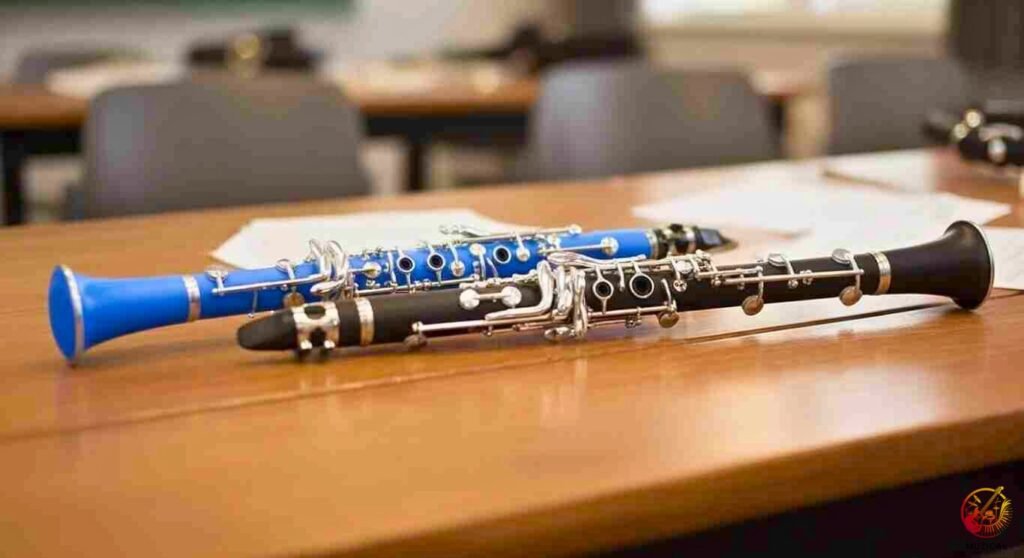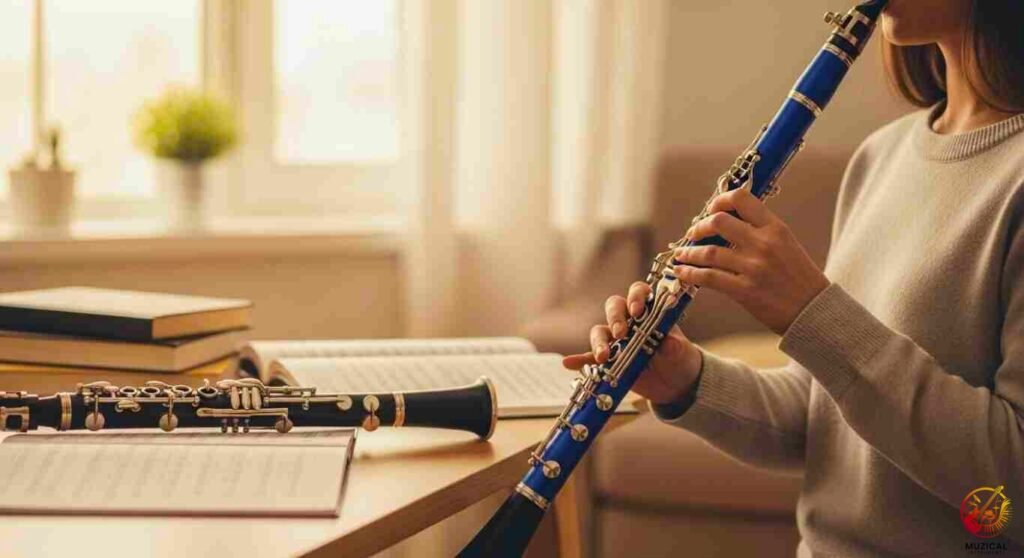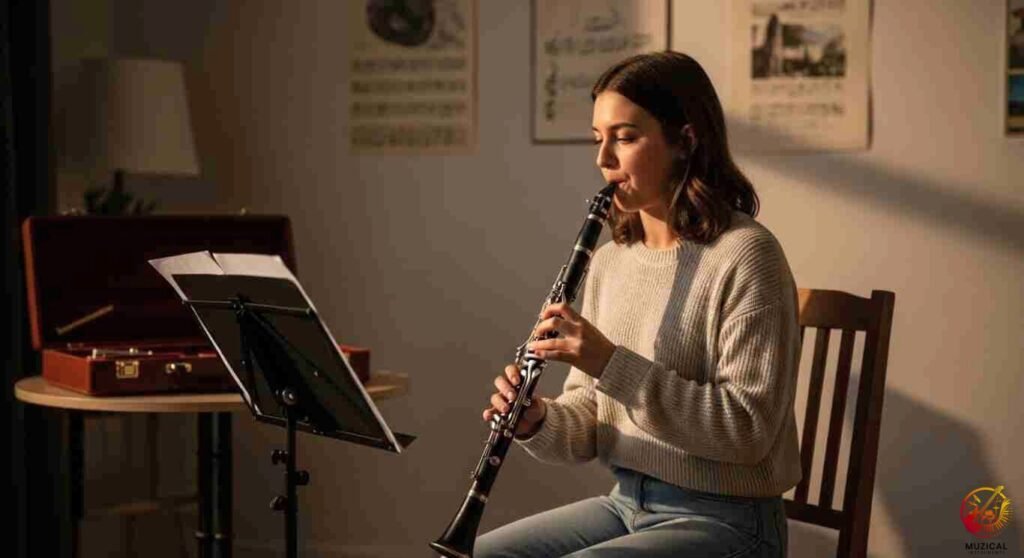Wood vs Plastic Clarinet: Which Is Best for Beginners?
The wood vs plastic clarinet choice can shape how your clarinet sounds, feels, and lasts. If you’re just starting out, it’s not only about price, it’s about what helps you learn better.
A plastic clarinet can take rough use and still play fine. It is easy to care for, and great for learning or outdoor use.
A wood clarinet gives a richer tone but needs more care and steady weather.
In this guide, you’ll learn when each one makes sense, how they differ, and which is best for you as a beginner.
By the end, you’ll know exactly where to start your clarinet journey.
Why the Clarinet’s Material Is a Big Deal

Clarinets come in two main types, plastic and wood. And yes, it matters a lot. Think of it like building a house. Vinyl siding is strong and easy to care for, while cedar wood looks beautiful but needs more care. Both work, but they feel and age differently.
The same goes for clarinets, the material shapes how your instrument sounds and lasts.
Plastic Clarinets
Most plastic clarinets are made from ABS resin, the same tough material used in LEGO bricks and car parts. Some use ebonite, a hard rubber that feels and sounds a bit closer to wood.
- Manufacturing: Plastic clarinets are molded, which keeps them affordable and consistent.
- Key Advantage: They don’t mind changes in weather or temperature, making them great for students, travel, or outdoor bands.
Wooden Clarinets
Professional clarinets are usually made from African Blackwood, also called Grenadilla. This dense wood gives a warm, rich, and deep tone that plastic can’t match.
- Craftsmanship: Each wooden clarinet is carefully crafted and drilled by hand for perfect sound.
- Key Disadvantage: Grenadilla wood is sensitive. It can expand, shrink, or even crack if it’s not cared for or kept in the right humidity.
Both types have their place. Plastic clarinets are strong and easy for beginners, while wooden ones reward careful players with a classic, beautiful tone.
Quick Comparison: Wood vs Plastic Clarinet
| Feature | Wooden Clarinet | Plastic (ABS / Resin) Clarinet |
|---|---|---|
| Tone / Sound Quality | Richer, warmer, full, complex overtones (preferred by many professionals) | Brighter, more direct, a bit less “warmth” |
| Durability / Sensitivity | Sensitive to temperature, humidity; may crack or warp under bad conditions | Very durable, resists cracking, handles rough usage better |
| Maintenance / Care | Needs regular oiling, careful storage, gradual temperature change | Low maintenance: swab after play, occasional cleaning |
| Cost | Usually higher price, more expensive materials & labor | More affordable for beginners; lower barrier to entry |
| Weight / Playability | Slightly heavier; sometimes more “resistance” to airflow | Lighter, easier for small hands |
| Suitability for Beginners | Riskier, needs care, environmental control | Safer choice, robust, forgiving |
Head to Head Comparison: Wood vs Plastic Clarinet

Let’s put them side by side. I tested and compared the two types across the most important categories for a new player. Here’s the breakdown.
1. Sound (Tonal Quality & Timbre)
This is the biggest wooden vs plastic clarinet difference.
- Plastic Clarinets: Produce a bright, focused, and very clear sound. It’s a very direct tonal quality. For a beginner, this is actually a good thing! It’s easier to produce a strong, steady note on a plastic instrument, which builds confidence. The sound has less complexity, or timbre.
- Wooden Clarinets: This is where the magic happens. The sound is described as dark, warm, rich, and full of color. The wood itself resonates, adding layers of overtones to the sound. The projection is often more powerful and can fill a concert hall. This is the sound you hear from professional players in orchestras.
The verdict for beginners: Plastic. The clear, easy to produce tone helps you focus on fundamentals like fingerings and forming a good embouchure.
2. Durability & Maintenance
How much work are you willing to put in?
- Plastic Clarinets: They are workhorses. You can take them from a hot car to an air-conditioned room without worrying. They don’t crack. Maintenance is simple: just swab it out after every time you play to remove moisture. That’s it.
- Wooden Clarinets: They are delicate. A new wooden clarinet needs a careful “breaking-in” period, where you only play it for short amounts of time to let the wood acclimate. You must swab it religiously, and you also need to oil the bore periodically to keep the wood from drying out. Sudden temperature changes are the enemy and can cause devastating cracks.
The verdict for beginners: Plastic, hands down. Learning an instrument is hard enough without also having to worry about your clarinet cracking.
3. Cost & Overall Value
Your wallet will notice the difference immediately.
- Plastic Clarinets: A good quality student model clarinet from a reputable brand like Yamaha or Jupiter will cost between $300 and $800. They also have good resale value when it’s time to upgrade.
- Wooden Clarinets: A new, beginner-friendly wooden clarinet (often called an intermediate clarinet) starts at around $1,000. Professional models from brands like Buffet Crampon or Selmer can easily cost over $5,000, with some reaching $10,000 or more.
The verdict for beginners: Plastic. It’s a much smaller financial risk, especially if you’re not 100% sure you’ll stick with the instrument for years.
The Final Verdict: What Is the Best Clarinet for Beginners?

Out of all the comparisons, plastic is the clear winner for almost every beginner.
The path to becoming a good clarinet player is long. The first year is all about learning the absolute basics:
- How to hold the instrument.
- How to form a proper embouchure (the way you shape your mouth).
- How to make a steady sound.
- How to read music and learn basic fingerings.
A plastic clarinet allows you to focus only on those things. It removes the stress of high cost and delicate maintenance. It’s a reliable tool designed specifically for learning.
When could a beginner start on wood?
It’s rare, but not impossible. A beginner could start on a wooden clarinet if:
- They are extremely dedicated. The student is serious, responsible, and taking private lessons from a great teacher.
- The parents understand the risks. They know the instrument needs careful handling and are willing to pay for repairs if it cracks.
- The budget allows for it. They can afford an intermediate wooden model without financial strain.
Even then, most teachers will recommend starting on plastic and upgrading after a year or two.
Common Mistakes Beginners Make
- Buying the cheapest plastic clarinet without checking keywork or seal
- Assuming wood is always better
- Failing to check for cracks or handling damage
- Neglecting mouthpiece & reed quality (those matter a lot)
- Skipping a good case or environmental protection
Final Recommendation
Start with plastic. Seriously.
The best clarinet for beginners is one you’ll actually practice. A $300 plastic clarinet that gets used daily beats a $1,500 wooden one that intimidates you.
Give yourself 6-12 months. Learn the basics. Develop good habits. Then assess your commitment.
If you’re practicing daily and loving it, upgrade to wood. If you’re losing interest, you haven’t wasted money on an expensive instrument you won’t use.
The wood vs plastic clarinet sound difference matters far less than consistent practice. I’ve heard beautiful music from plastic clarinets and awful squeaks from expensive wooden ones.
Choose based on where you are now, not where you hope to be. You can always upgrade later. Many professional clarinetists started on plastic instruments.
Focus on finding a quality instrument from reputable brands: Yamaha, Buffet Crampon, Selmer, or Jean Paul USA for budget options. Avoid no-name brands from big-box stores.
Get a good teacher. Practice regularly. The material of your clarinet matters far less than the time you spend with it.
FAQ: Wood vs Plastic Clarinet
Here are answers to the most common questions about choosing a beginner clarinet.
1. Is a wood or plastic clarinet better for a beginner?
A plastic clarinet is almost always better for a beginner. They are much tougher, easier to take care of, and more affordable. This lets you focus on learning how to play without worrying about damaging an expensive, delicate instrument.
2. Do plastic clarinets sound bad?
Not at all! A good quality plastic clarinet made by a trusted brand like Yamaha or Jupiter has a very clear and focused sound. For a beginner, this bright tone is actually helpful because it’s easier to produce a strong, steady note. While a wooden clarinet sounds warmer and richer, a student model is designed perfectly for learning.
3. How can you tell if a clarinet is wood or plastic?
The easiest way is to look at the surface. A wooden clarinet, usually made from Grenadilla, will have a visible wood grain, like lines on a piece of furniture. A plastic clarinet will have a perfectly smooth, uniform, and slightly shiny black surface with no grain pattern. Wooden clarinets also feel a bit heavier.
4. Are wooden clarinets harder to play?
They aren’t harder to play in terms of fingerings, but they do require more care and better breath control. Wooden clarinets have more “resistance,” which means you need to use your air more effectively to create a rich sound. They are also very sensitive to temperature and humidity, which makes them harder to maintain.
5. How much should I spend on a good beginner clarinet?
You should expect to spend between $400 and $700 for a new, high-quality plastic student clarinet. Avoid the super-cheap clarinets under $200 found online, as they often have problems with staying in tune, break easily, and can make learning frustrating.
6. Why do wooden clarinets crack?
Wooden clarinets crack because the wood expands and contracts with changes in temperature and moisture. If a cold clarinet is warmed up too quickly, or if moisture from your breath isn’t swabbed out properly, the stress can cause the wood to split. This is the main reason why durable plastic is recommended for beginners.
7. When should I upgrade from a plastic to a wooden clarinet?
Most students are ready to upgrade after playing for about two to three years. By then, you will have mastered the basics, developed a good practice routine, and decided that you are serious about continuing with the instrument. Upgrading to an intermediate wooden clarinet is a great way to take your sound to the next level.
